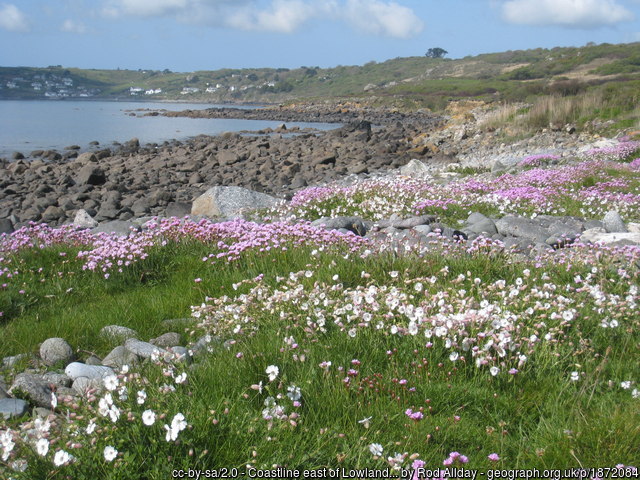Mention The Lizard, and you may think of the wild west coast, with its serpentine cliffs and iconic coves, or the open expanse of heathland at Goonhilly. Delve a little deeper though and there are many less well known treasures waiting to be explored.
One such place is Lowland Point, forming the northern edge of the bay in which the east coast fishing village of Coverack sits.
 Springtime thrift and sea campion, and the view back to Coverack – Rod Allday – geograph.org.uk
Springtime thrift and sea campion, and the view back to Coverack – Rod Allday – geograph.org.uk
Whichever way you choose to approach, it’s no short walk in. Consequently Lowland is a tranquil spot, especially since adjacent Dean Quarry has been silent for almost two decades, having previously produced road and other stone, much of which was shipped out from the quarry’s now abandoned jetty.
Both Dean and Lowland are underlain by gabbro, part of the Lizard suite of rocks, but lesser known than its more unusual neighbour serpentine. Lowland is aptly named, as viewed from afar it is indeed low land. Geomorphologically speaking, this flat coastal platform, just a few metres above sea level, is a raised beach, formed during the last ice age when sea levels fell. The ‘cliffs’ are now ¼ mile inland, and clothed in heath and elm woodland. The raised beach supports an interesting mix of wet willow woodland, and flowery pastures, with at least one seasonal pond adjacent to the coastpath.

Lowland viewed from the relict cliffs above – Dereck Voller – geograph.org.uk
Although Lowland lacks many of the iconic Lizard plant species revered by botanists (because they often favour serpentine or schist geologies) careful stewardship means it supports varied wildlife, often long since lost elsewhere where farming has become more intensive, and less tolerant of boggy patches!
Lowland has gained a devoted following amongst entomologists, as the combination of soft clay eroding sea cliffs (for nesting tunnels), and flowery pastures (for nectar/pollen) makes ideal insect habitat.
Female potter wasps diligently construct their distinctive nests out of mud, after carefully mixing earth and water to the correct consistency, and flying in with their building materials. The nest will be stuffed by the wasp with moth caterpillars, which, once sealed into the pot with a little more mud, have the unfortunate role of becoming lunch when the wasp’s single egg hatches.
One of Lowland’s star species is the Long-horned mining bee, named for the male’s oversized antennae, which help them sniff out females.
 Long-horned mining bee (Link to video of Long-horned bee)
Long-horned mining bee (Link to video of Long-horned bee)
This priority species was once relatively common, but has declined with the loss of flower-rich pasture to a few dozen sites nationally, with Lowland Point being one of only seven Cornish sites currently for it. The adults visit the flowers of vetches and other legumes, and provision their larvae with nectar and pollen. They excavate nesting tunnels, perhaps up to 15cm in length, in the soft sea cliffs, and create chambers in which their young can develop.
If you fancy taking a stroll out to explore Lowland Point it can be reached in about half an hour along the coastpath from Coverack, or alternatively there is a path that drops down from the hamlet of Treglohan, skirting the edge of Dean Quarry.
It’s well worth the effort!
Published: July 2018
Author: Rachel Holder (Area Ranger, The Lizard)
